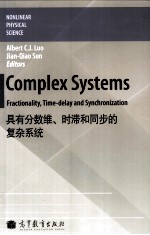图书介绍
具有分数维、时滞和同步的复杂系统 英文PDF|Epub|txt|kindle电子书版本网盘下载

- C. J. Luo,Jian-Qiao Sun 著
- 出版社: 北京:高等教育出版社
- ISBN:9787040297102
- 出版时间:2011
- 标注页数:371页
- 文件大小:23MB
- 文件页数:384页
- 主题词:复杂性理论-英文
PDF下载
下载说明
具有分数维、时滞和同步的复杂系统 英文PDF格式电子书版下载
下载的文件为RAR压缩包。需要使用解压软件进行解压得到PDF格式图书。建议使用BT下载工具Free Download Manager进行下载,简称FDM(免费,没有广告,支持多平台)。本站资源全部打包为BT种子。所以需要使用专业的BT下载软件进行下载。如BitComet qBittorrent uTorrent等BT下载工具。迅雷目前由于本站不是热门资源。不推荐使用!后期资源热门了。安装了迅雷也可以迅雷进行下载!
(文件页数 要大于 标注页数,上中下等多册电子书除外)
注意:本站所有压缩包均有解压码: 点击下载压缩包解压工具
图书目录
1 New Treatise in Fractional Dynamics&Dumitru Baleanu1
1.1 Introduction1
1.2 Basic definitions and properties of fractional derivatives and integrals3
1.3 Fractional variational principles and their applications10
1.3.1 Fractional Euler-Lagrange equations for discrete systems11
1.3.2 Fractional Hamiltonian formulation13
1.3.3 Lagrangian formulation of field systems with fractional derivatives20
1.4 Fractional optimal control formulation23
1.4.1 Example24
1.5 Fractional calculus in nuclear magnetic resonance27
1.6 Fractional wavelet method and its applications in drug analysis32
References35
2 Realization of Fractional-Order Controllers:Analysis,Synthesis and Application to the Velocity Control of a Servo System&Ramiro S.Barbosa,Isabel S.Jesus,Manuel F.Silva,J.A.Tenreiro Machado43
2.1 Introduction43
2.2 Fractional-order control systems45
2.2.1 Basic theory45
2.2.2 Fractional-Order controllers and their implementation47
2.3 Oustaloup's frequency approximation method49
2.4 The experimental modular servo system50
2.5 Mathematical modelling and identification of the servo system50
2.6 Fractional-order real-time control system53
2.7 Ziegler-Nichols tuning rules54
2.7.1 Ziegler-Nichols tuning rules:quarter decay ratio55
2.7.2 Ziegler-Nichols tuning rules:oscillatory behavior59
2.7.3 Comments on the results61
2.8 A simple analytical method for tuning fractional-order controllers63
2.8.1 The proposed analytical tuning method65
2.9 Application of optimal fractional-order controllers69
2.9.1 Tuning of the PID and PIλD controllers70
2.10 Conclusions77
References78
3 Differential-Delay Equations&Richard Rand83
3.1 Introduction83
3.2 Stability of equilibrium84
3.3 Lindstedt's method85
3.4 Hopf bifurcation formula88
3.4.1 Example190
3.4.2 Derivation91
3.4.3 Example 292
3.4.4 Discussion93
3.5 Transient behavior94
3.5.1 Example94
3.5.2 Exact solution95
3.5.3 Two variable expansion method(also known as multiple scales)95
3.5.4 Approach to limit cycle97
3.6 Center manifold analysis97
3.6.1 Appendix:The adjoint operator A107
3.7 Application to gene expression108
3.7.1 Stability of equilibrium109
3.7.2 Lindstedt's method111
3.7.3 Numerical example113
3.8 Exercises114
References115
4 Analysis and Control of Deterministic and Stochastic Dynamical Systems with Time Delay&Jian-Qiao Sun,Bo Song119
4.1 Introduction119
4.1.1 Deterministic systems120
4.1.2 Stochastic systems122
4.1.3 Methods of solution122
4.1.4 Outline of the chapter124
4.2 Abstract Cauchy problem for DDE124
4.2.1 Convergence with Chebyshev nodes126
4.3 Method of semi-discretization127
4.3.1 General time-varying systems129
4.3.2 Feedback controls130
4.3.3 Analysis of the method of semi-discretization133
4.3.4 High order control138
4.3.5 Optimal estimation139
4.3.6 Comparison of semi-discretization and higher order control140
4.4 Method of continuous time approximation143
4.4.1 Control problem formulations144
4.5 Spectral properties of the CTA method146
4.5.1 A low-pass filter based CTA method149
4.5.2 Example of a first order linear system150
4.6 Stability studies of time delay systems153
4.6.1 Stability with Lyapunov-Krasovskii functional153
4.6.2 Stability with Padé approximation155
4.6.3 Stability with semi-discretization156
4.6.4 Stability of a second order LTI system156
4.7 Control of LTI systems163
4.8 Control of the Mathieu system167
4.9 An experimental validation172
4.10 Supervisory control174
4.10.1 Supervisory Control of the LTI System175
4.10.2 Supervisory control of the periodic system178
4.11 Method of semi-discretization for stochastic systems181
4.11.1 Mathematical background181
4.11.2 Stability analysis183
4.12 Method of finite-dimensional markov process(FDMP)184
4.12.1 Fokker-Planck-kolmogorov(FPK)equation185
4.12.2 Moment equations186
4.12.3 Reliability187
4.12.4 First-passage time probability188
4.12.5 Pontryagin-Vittequations189
4.13 Analysis of stochastic systems with time delay190
4.13.1 Stability of second order stochastic systems190
4.13.2 One Dimensional Nonlinear System196
References198
5 Synchronization of Dynamical Systems in Sense of Metric Functionals of Specific Constraints&Albert C.J.Luo205
5.1 Introduction205
5.2 System synchronization208
5.2.1 Synchronization of slave and master systems208
5.2.2 Generalized synchronization214
5.2.3 Resultant dynamical systems216
5.2.4 Metric functionals220
5.3 Single-constraint synchronization223
5.3.1 Synchronicity223
5.3.2 Singularity to constraint227
5.3.3 Synchronicity with singularity231
5.3.4 Higher-order singularity232
5.3.5 Synchronization to constraint236
5.3.6 Desynchronization to constraint252
5.3.7 Penetration to constraint257
5.4 Multiple-constraint synchronization261
5.4.1 Synchronicity to multiple-constraints261
5.4.2 Singularity to constraints264
5.4.3 Synchronicity with singularity to multiple constraints267
5.4.4 Higher-order singularity to constraints270
5.4.5 Synchronization to all constraints274
5.4.6 Desynchronization to all constraints279
5.4.7 Penetration to all constraints284
5.4.8 Synchronization-desynchronization-penetration287
5.5 Conclusions294
References294
6 The Complexity in Activity of Biological Neurons&Yong Xie,Jian-Xue Xu299
6.1 Complicated firing patterns in biological neurons300
6.1.1 Time series of membrane potential300
6.1.2 Firing patterns:spiking and bursting300
6.2 Mathematical models306
6.2.1 HH model306
6.2.2 FitzHugh-Nagumo model307
6.2.3 Hindmarsh-Rose model308
6.3 Nonlinear mechanisms of firing patterns309
6.3.1 Dynamical mechanisms underlying TypeⅠexcitability and TypeⅡexcitability309
6.3.2 Dynamical mechanism for the onset of firing in the HH model310
6.3.3 TypeⅠexcitability and TypeⅡexcitability displayed in the Morris-Lecar model311
6.3.4 Change in types of neuronal excitability via bifurcation control314
6.3.5 Bursting and its topological classification322
6.3.6 Bifurcation,chaos and Crisis324
6.4 Sensitive responsiveness of aperiodic firing neurons to external stimuli326
6.4.1 Experimental phenomena326
6.4.2 Nonlinear mechanisms328
6.5 Synchronization between neurons334
6.5.1 Significance of synchronization in the nervous system334
6.5.2 Coupling:electrical coupling and chemical coupling335
6.6 Role of noise in the nervous system337
6.6.1 Constructive role:stochastic resonance and coherence resonance337
6.6.2 Stochastic resonance:When does it not occur in neuronal models?338
6.6.3 Global dynamics and stochastic resonance of the forced FitzHugh-Nagumo neuron model339
6.6.4 A novel dynamical mechanism of neural excitability for integer multiple spiking342
6.6.5 A Further Insight into Stochastic Resonance in an Integrate-and-fire Neuron with Noisy Periodic Input345
6.6.6 Signal-to-noise ratio gain of a noisy neuron that transmits subthreshold periodic spike trains352
6.6.7 Mechanism of bifurcation-dependent coherence resonance of Morris-Lecar Model352
6.7 Analysis of time series of interspike intervals353
6.7.1 Return map353
6.7.2 Phase space reconstruction353
6.7.3 Extraction of unstable periodic orbits355
6.7.4 Nonlinear prediction and surrogate data methods356
6.7.5 Nonlinear characteristic numbers358
6.8 Application362
6.9 Conclusions363
References363